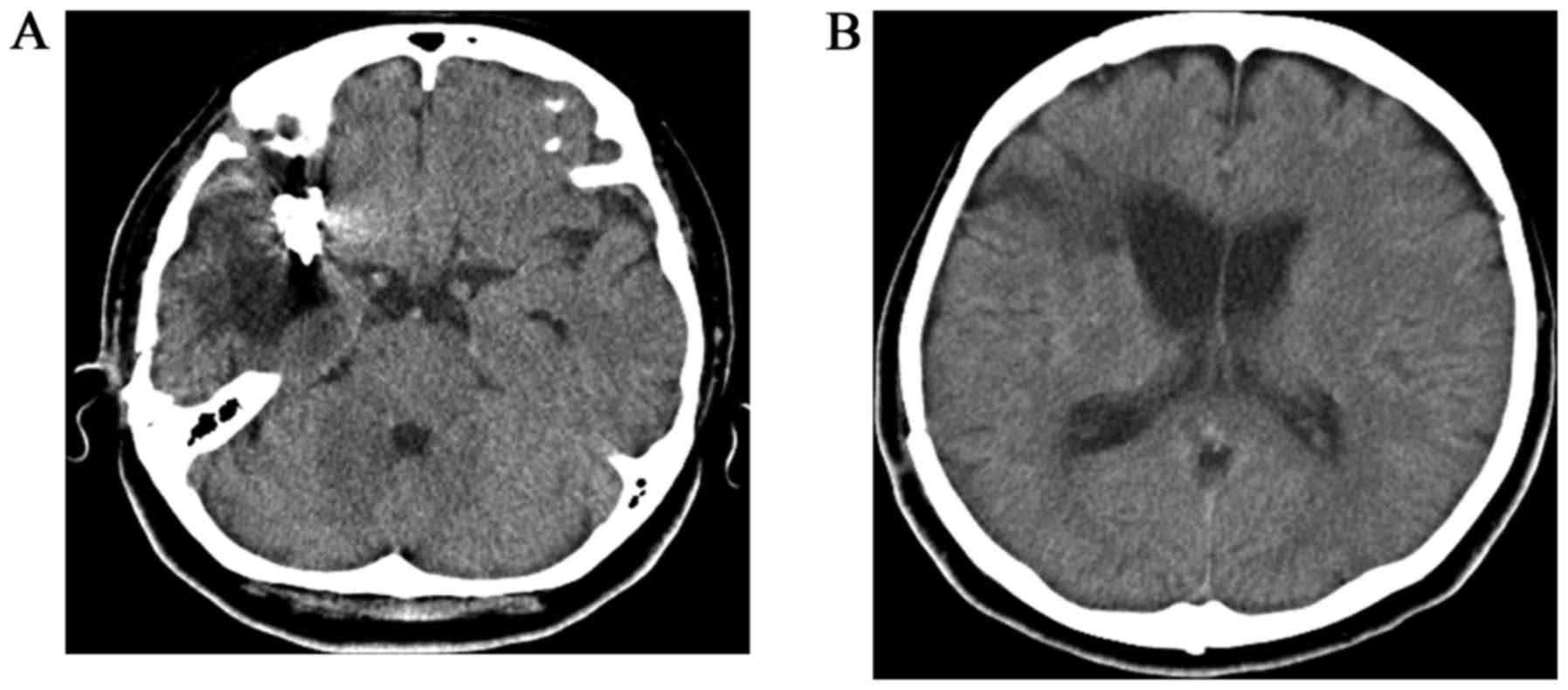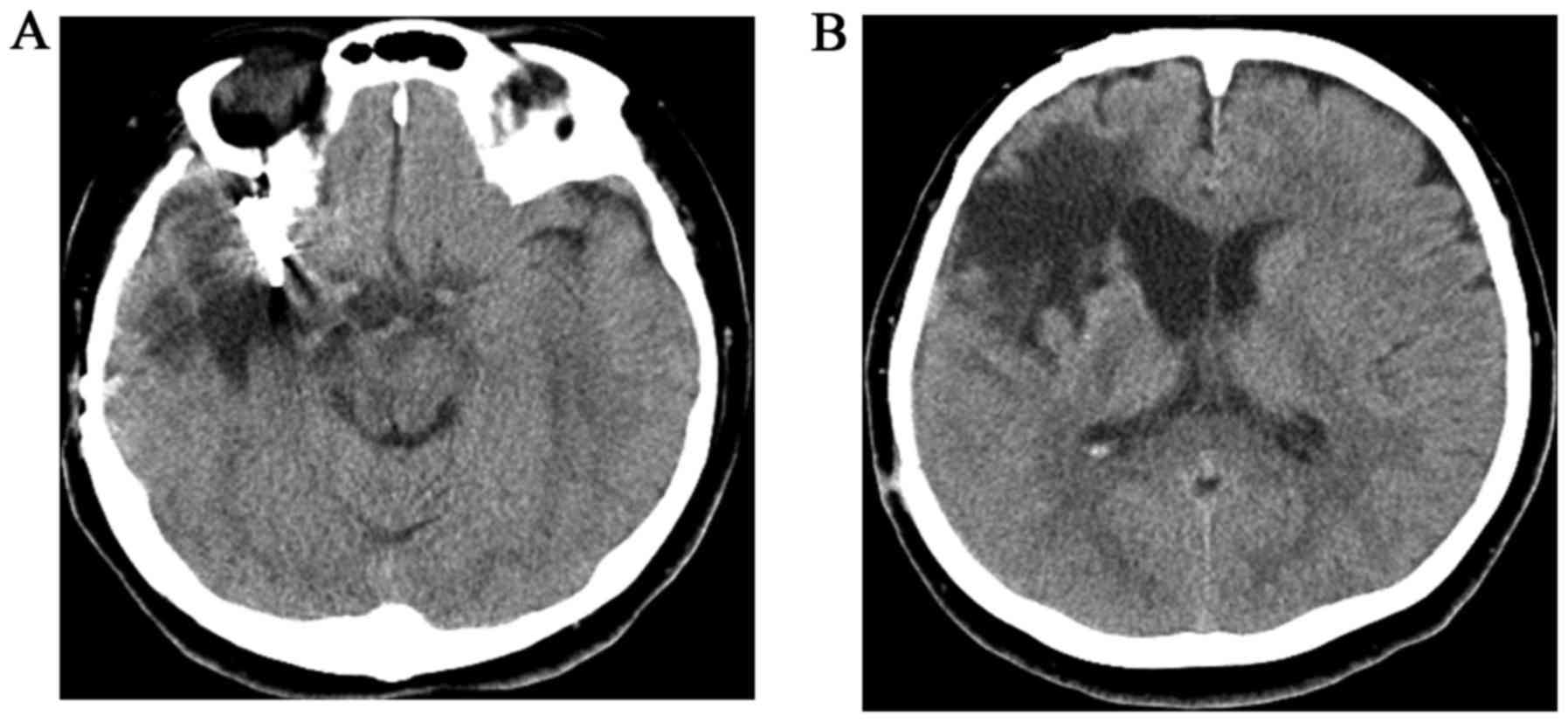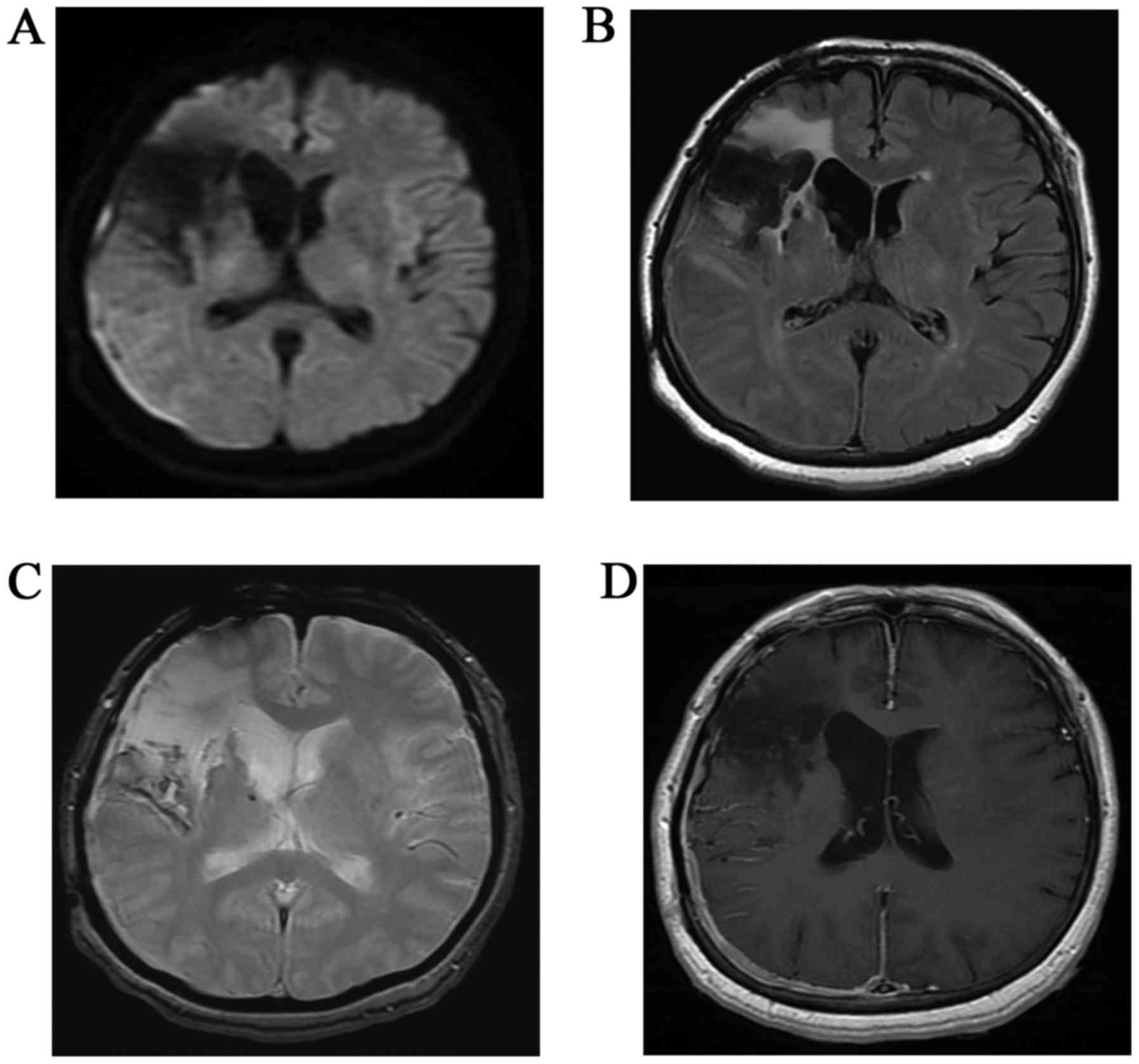Secondary central nervous system lymphoma surrounding a region injured by subarachnoid hemorrhage and subsequent aneurysmal clipping
- Authors:
- Published online on: September 11, 2017 https://doi.org/10.3892/br.2017.981
- Pages: 474-476
Abstract
Introduction
Leptomeningeal infiltration is frequently encountered (1), and dural infiltration is not rare with secondary central nervous system (CNS) lymphoma (1,2). However, unless systemic lymphoma has already been identified, a finding of subdural and subarachnoid abnormality would not be directly linked to lymphoma (3). Furthermore, computed tomography (CT) and magnetic resonance imaging (MRI) abnormalities surrounding hemorrhagic and postoperative changes make it difficult to distinguish between onset of disease and postoperative complications, including metal artifacts. However, malignant cells that enter the CNS appear first in the dura and subarachnoid space in rats with a blood brain barrier (BBB) disrupted by focal injury following exposure to a cold temperature (4). Previous history of subarachnoid hemorrhage (SAH) and aneurysm clipping may be associated with CNS infiltration in systemic lymphoma. The current study describes a particularly rare case of systemic lymphoma involving the CNS overlapping with the area of injury to the dura and leptomeninges due to an aneurysmal SAH. To the best of our knowledge, no similar cases have previously been reported.
Case report
A 56-year-old woman with a history of aneurysm clipping following acute SAH due to rupture of the right middle cerebral arterial aneurysm 6 years earlier (Fig. 1) was hospitalized at Kochi Health Sciences Center for sudden numbness of the left arm. The patient had not experienced malignant or benign diseases within the 6 years since discharge from hospital. The patient had been asymptomatic except for partial paralysis due to SAH. Unenhanced CT was performed to exclude the recurrence of SAH, and it revealed slurred fissures of the right parietal region and enlargement of the low-density area surrounding the preceding hemorrhagic scar was suspected (Fig. 2). In addition, MRI was performed (Fig. 3). Diffusion-weighted imaging (DWI) demonstrated a thin crescent of hyperintensity in the right temporo-occipital region, although the parenchyma near the right Sylvian fissure exhibited loss of signal with distortion due to a magnetic susceptibility artifact. Fluid-attenuated inversion recovery (FLAIR) demonstrated slurred fissures of the right temporo-occipital region, and hyperintensity near the Sylvian fissure. T2-weighted gradient echo imaging (T2WI) demonstrated linear hypointensities along the surface of the right cerebral hemisphere as superficial siderosis from hemosiderin deposits caused by SAH. Enhanced axial T1-weighted imaging demonstrated intense homogeneous enhancement along the dura, and subarachnoid linear enhancement in the right temporo-occipital region. A subdural mass showing enhancement was strongly suspected. However, subarachnoid enhancement or FLAIR hyperintensity near the right Sylvian fissure resulted in confusion between the presence of novel lesions or postoperative complications. Prior to surgery, meningioma with postoperative change was suspected on the basis of subdural hyperintensity on DWI. Intraoperatively, the dura mater and subarachnoid space exhibited a grayish-yellow mass, and malignant lymphoma was diagnosed pathologically. Subsequent systemic examination by gallium scintigraphy and CT revealed multiple mediastinal and paraaortic lymph node swellings. Following CT, neck lymph nodes began to demonstrate rapid increases in size. Serum interleukin-2 receptor and β2-microglobulin levels were high, at 2,170 mg/l (normal, <519 mg/ml) and 5.0 U/ml (normal, <1.9 U/ml), respectively. Bone marrow findings were consistent with CNS lymphoma (non-Hodgkin's B-cell type; stage IV). Based upon positive results for cyclin D1 postoperatively, mantle cell lymphoma was proposed, although the subtype was not confirmed. At the time of writing, the patient is undergoing systemic chemotherapy with a combination of rituximab, methotrexate and cytalabine.
Discussion
Subdural and subarachnoid enhancement on MRI may be indicative of a variety of differential diagnoses from benign to malignant, such as sarcoidosis, meningitis and metastatic tumors with leptomeningeal dissemination other than secondary lymphoma (5). MRI findings were consistent with CNS invasion by lymphoma (2); however, lymphoma were not considered amongst the more likely options. CT or MRI abnormalities overlapping a previously injured region indicating a complication from surgery could not be excluded. In the present case, subdural crescent enhancement identified on MRI were exhibited as slurred fissures by CT. In addition, DWI was distorted by magnetic susceptibility artifacts; in retrospect, the subarachnoid findings of FLAIR and the enhanced MRI were consistent with the surgical features of leptomeningeal infiltration (6). Prominent subarachnoid enhancement on contrast-enhanced T1WI may depict evidence of malignancy; however, her past history had to be taken into account.
Should systemic lymphoma be revealed in advance, invasion of the CNS may be included in the differential diagnosis, regardless of how distorted the CT or MRI findings are. Although primary leptomeningeal or dural lymphoma is rare (7,8), secondary CNS invasion is not. CNS involvement in non-Hodgkin's lymphoma tends to occur early, at a median of 5–6 months subsequent to the primary diagnosis of systemic lymphoma (3). Lymphoma in the current patient would represent an aggressive subtype according to the rapid increase in the size of neck lymph nodes.
Exactly why secondary lymphoma tends to present the dural or leptomeningeal spread remains unknown. However, lymphoma cells hypothetically spread from retroperitoneal lymph nodes or bone marrow to the leptomeninges via the intervertebral nervous plexus (9). Aho et al (4) reported that malignant cells appeared to enter the CNS through a deficiency in the BBB around the subarachnoid vessels. Composite meningioma and lymphoma has been reported as a form of tumor-to-tumor metastasis (10). Previous disruption of the BBB by meningioma may be considered as the grounds for invasion of CNS lymphoma. In the present case, the BBB of the broad area surrounding the right Sylvian fissure had been disrupted by acute SAH and subsequent surgery 6 years earlier. CNS invasion by lymphoma may be associated with disruption of the BBB. Although confirmatory evidence is lacking, the possibility remains that subdural and leptomeningeal invasion of lymphoma occurred through disruption of the BBB by SAH and subsequent clipping.
In conclusion, the current study presents a case of CNS invasion by systemic lymphoma that was difficult to radiologically diagnose due to overlap with an area previously affected by SAH and a subsequent surgical scar. It is proposed that radiologists assess the possibility of invasion by CNS lymphoma in the presence of meningeal abnormality overlapping an injured region.
References
|
Haldorsen IS, Espeland A and Larsson EM: Central nervous system lymphoma: Characteristic findings on traditional and advanced imaging. AJNR Am J Neuroradiol. 32:984–992. 2011. View Article : Google Scholar : PubMed/NCBI | |
|
Koeller KK, Smirniotopoulos JG and Jones RV: Primary central nervous system lymphoma: Radiologic-pathologic correlation. Radiographics. 17:1497–1526. 1997. View Article : Google Scholar : PubMed/NCBI | |
|
Hill QA and Owen RG: CNS prophylaxis in lymphoma: Who to target and what therapy to use. Blood Rev. 20:319–332. 2006. View Article : Google Scholar : PubMed/NCBI | |
|
Aho R, Vaittinen S, Jahnukainen K and Kalimo H: Spread of malignant lymphoid cells into rat central nervous system with intact and disrupted blood-brain barrier. Neuropathol Appl Neurobiol. 20:551–561. 1994. View Article : Google Scholar : PubMed/NCBI | |
|
Guermazi A, Lafitte F, Miaux Y, Adem C, Bonneville JF and Chiras J: The dural tail sign-beyond meningioma. Clin Radiol. 60:171–188. 2005. View Article : Google Scholar : PubMed/NCBI | |
|
Stuckey SL, Goh TD, Heffernan T and Rowan D: Hyperintensity in the subarachnoid space on FLAIR MRI. AJR Am J Roentgenol. 189:913–921. 2007. View Article : Google Scholar : PubMed/NCBI | |
|
Taylor JW, Flanagan EP, O'Neill BP, Siegal T, Omuro A, Deangelis L, Baehring J, Nishikawa R, Pinto F, Chamberlain M, et al: Primary leptomeningeal lymphoma: International Primary CNS Lymphoma Collaborative Group report. Neurology. 81:1690–1696. 2013. View Article : Google Scholar : PubMed/NCBI | |
|
Johnson BA, Fram EK, Johnson PC and Jacobowitz R: The variable MR appearance of primary lymphoma of the central nervous system: Comparison with histopathologic features. AJNR Am J Neuroradiol. 18:563–572. 1997.PubMed/NCBI | |
|
Levitt LJ, Dawson DM, Rosenthal DS and Moloney WC: CNS involvement in the non-Hodgkin's lymphomas. Cancer. 45:545–552. 1980. View Article : Google Scholar : PubMed/NCBI | |
|
Martin SE, Khalidi HS and Hattab EM: Marginal zone B-cell lymphoma involving a longstanding fibrous meningioma: An initial manifestation of systemic disease. Hum Pathol. 44:2609–2613. 2013. View Article : Google Scholar : PubMed/NCBI |












